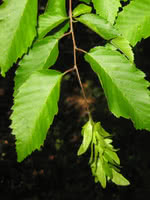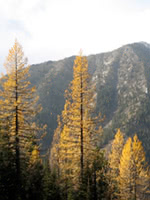Mon-Fri 9am - 5pm Mountain time
Blue Beech vs Western Larch
Carpinus caroliniana
Larix occidentalis
NOT AVAILABLE THIS SEASON - MIGHT RETURN
Blue Beech is a beautiful, ornamental tree with enticing features. The foliage transforms throughout the season, offering a kaleidoscope of color. New leaves emerge reddish-purple, transforming to dark green, and then turn striking shades of yellow, orange, and red in fall. Once all the foliage has dropped, grooved, blue-grey bark becomes striking on a winter landscape.
Blue Beech has an attractive globular shape and has been successfully grown in both full shade and full sun locations. Make sure you provide ample moisture to ensure this tree thrives.
Western Larch is a pioneer species that can survive in nutrient poor soil and is found in the valleys and on the lower slopes of mountains in mixed forests. In the warm months, this larch is covered in clusters of soft green needles that turn golden yellow before dropping in the fall. Its dense, sturdy wood is excellent for lumber, making this Larch valuable in Western North America.

